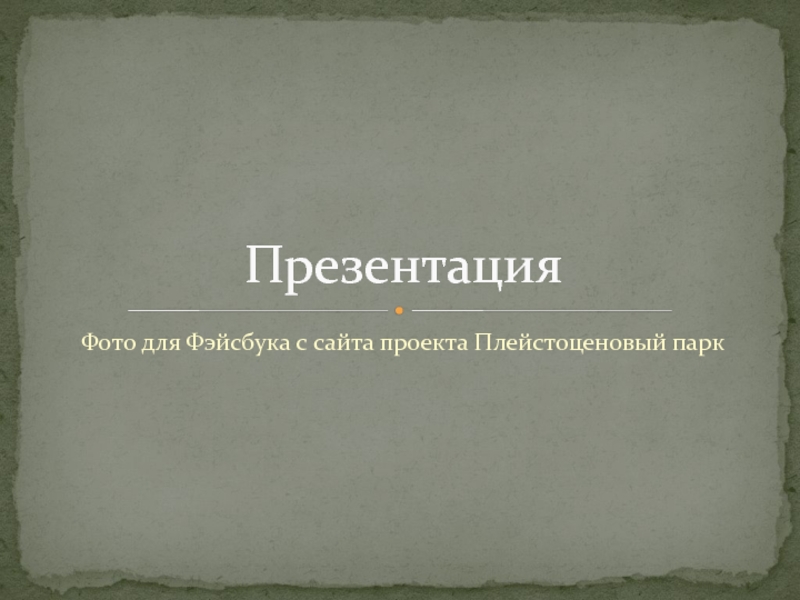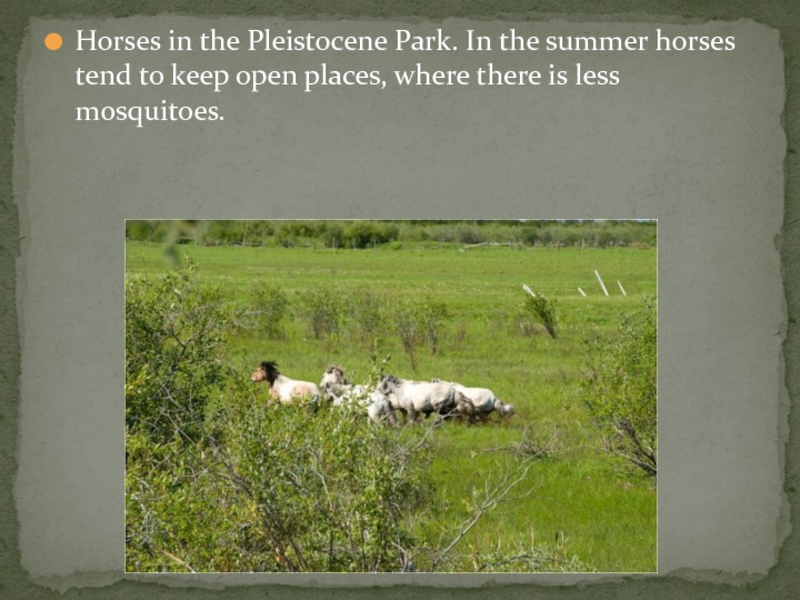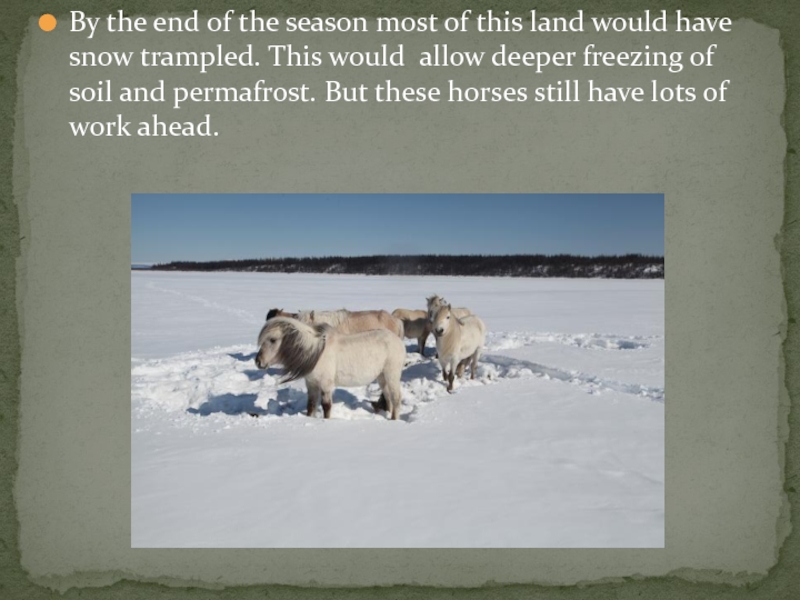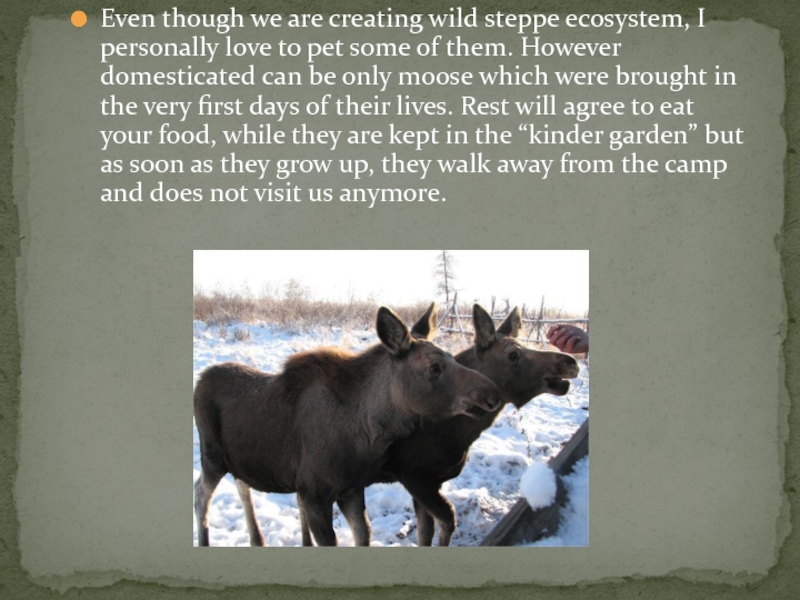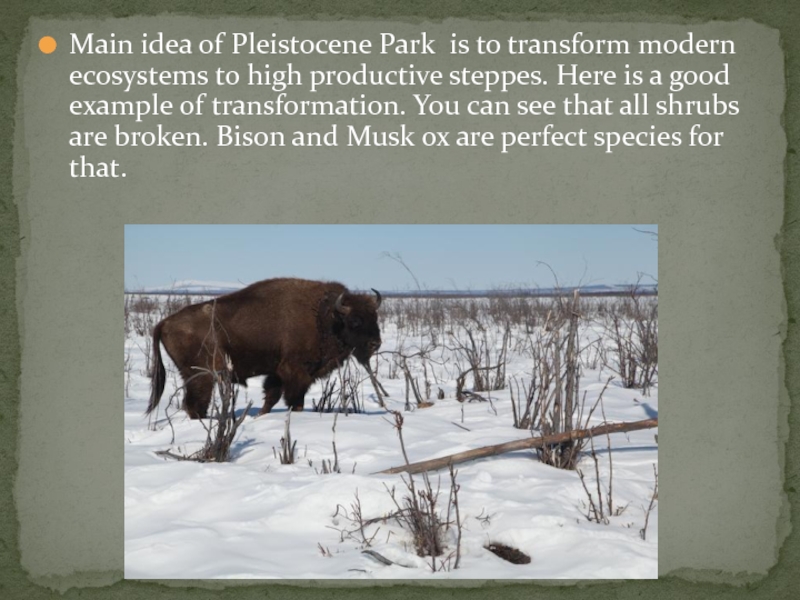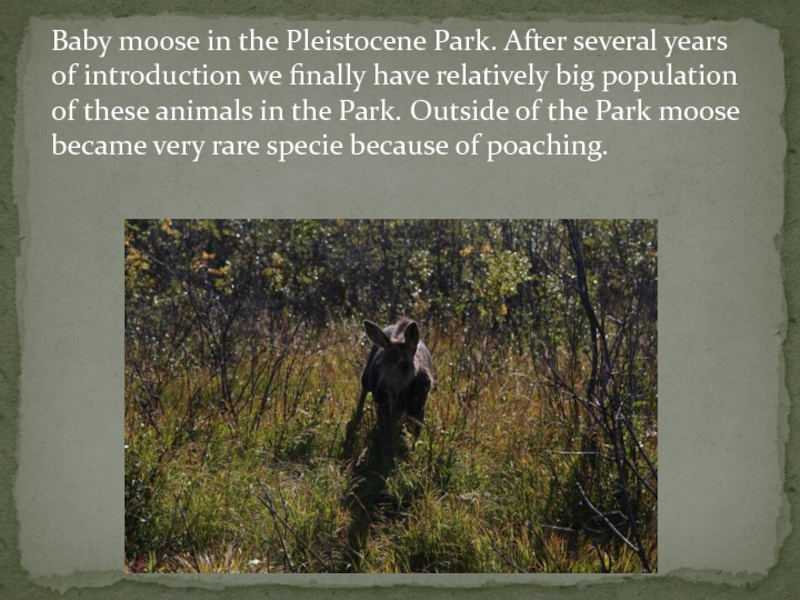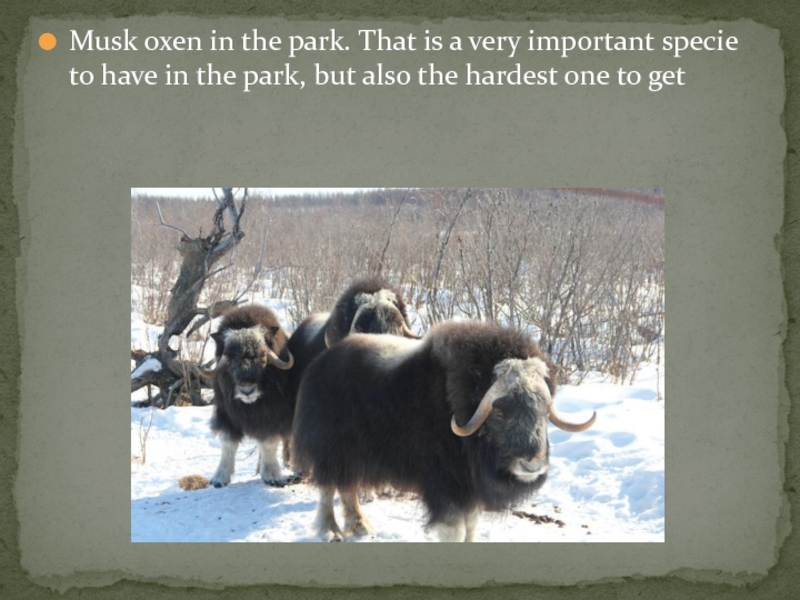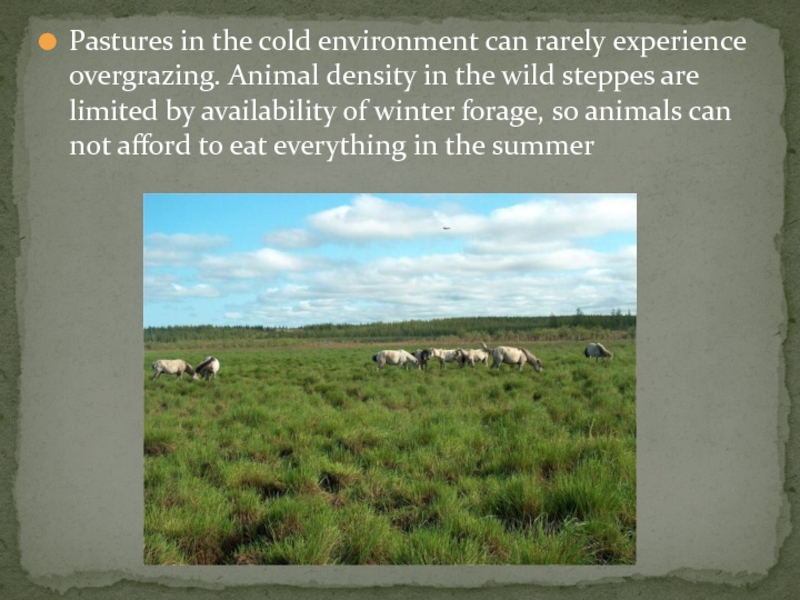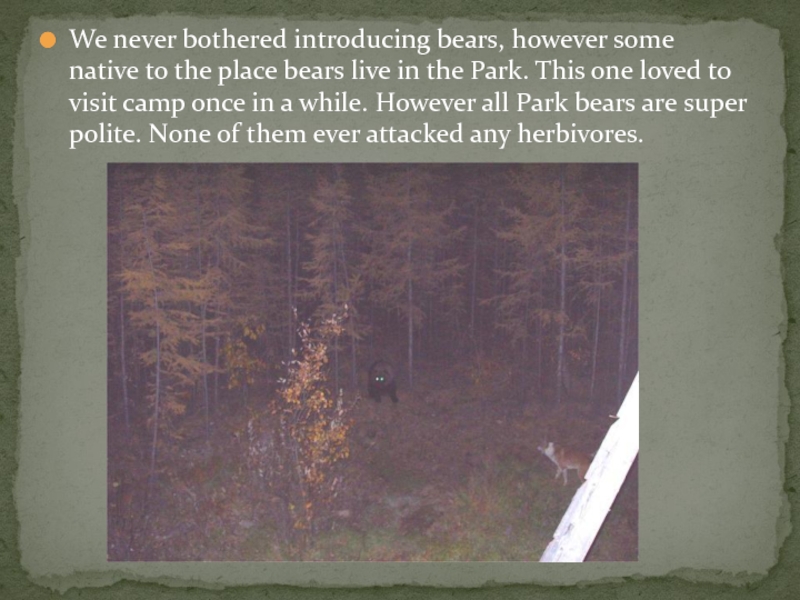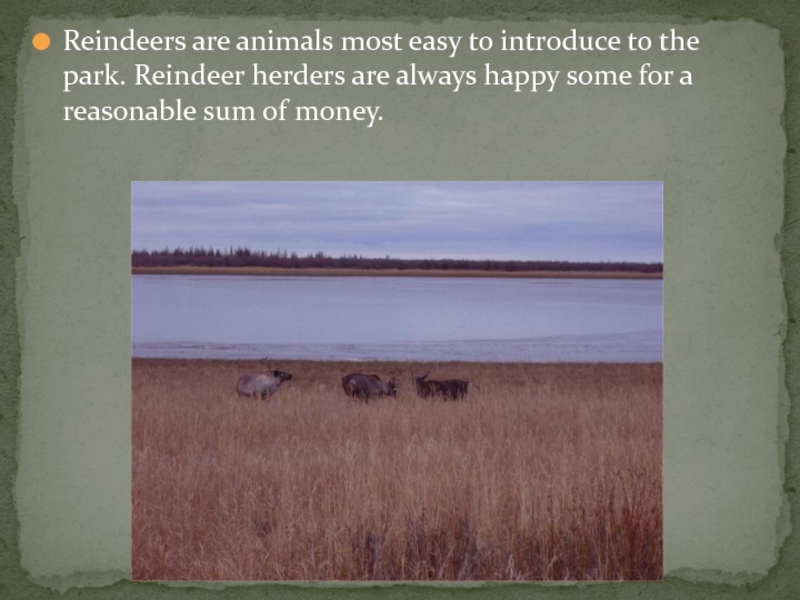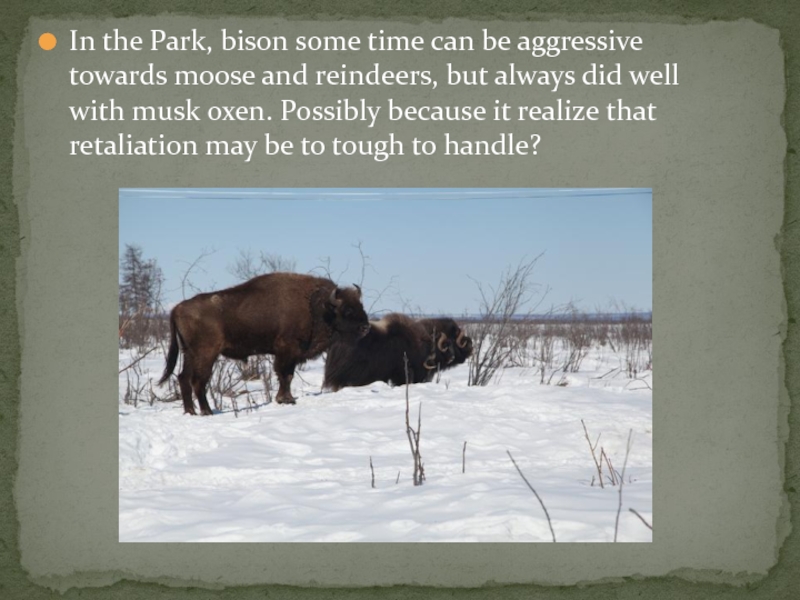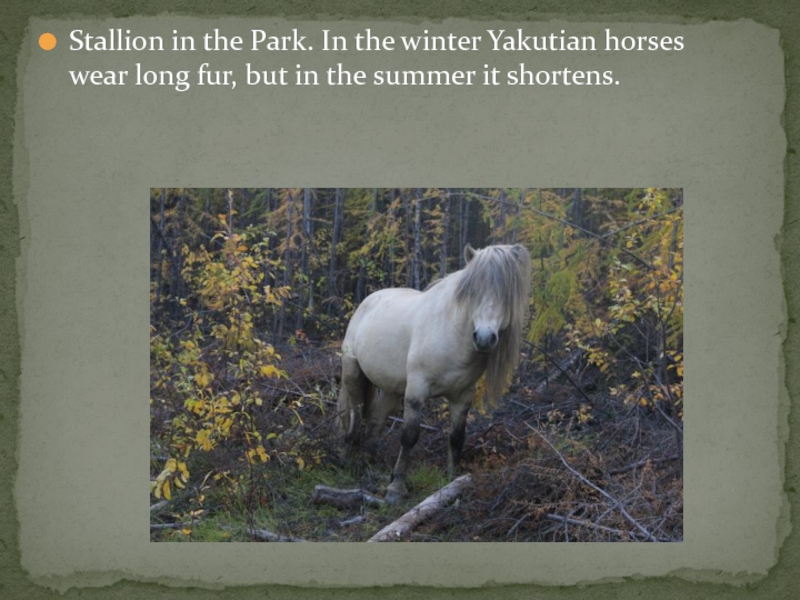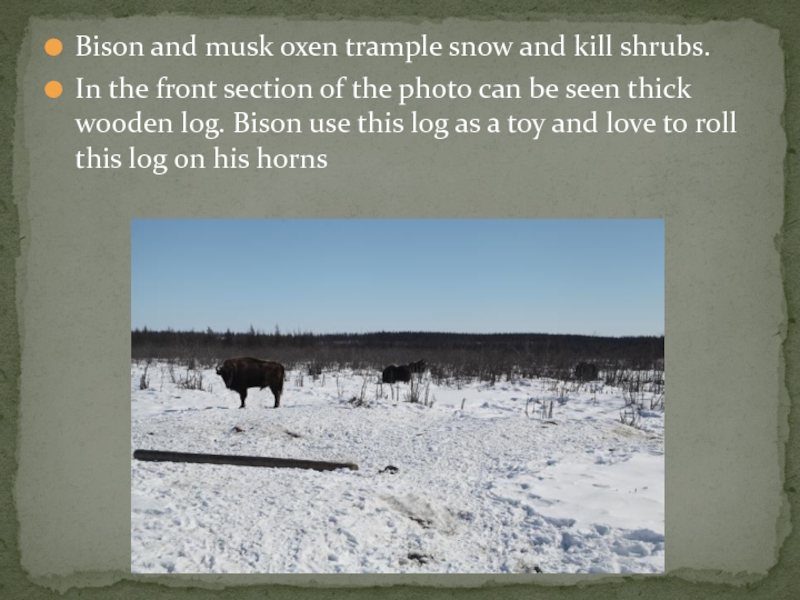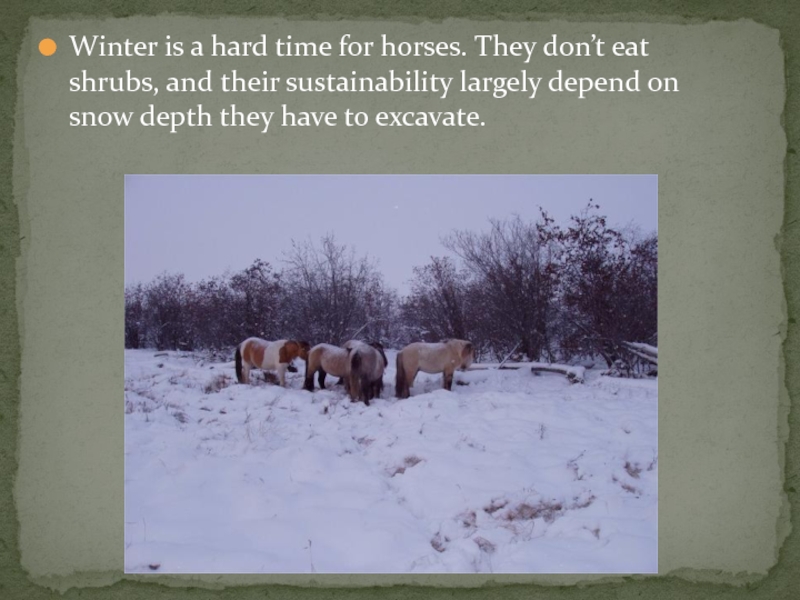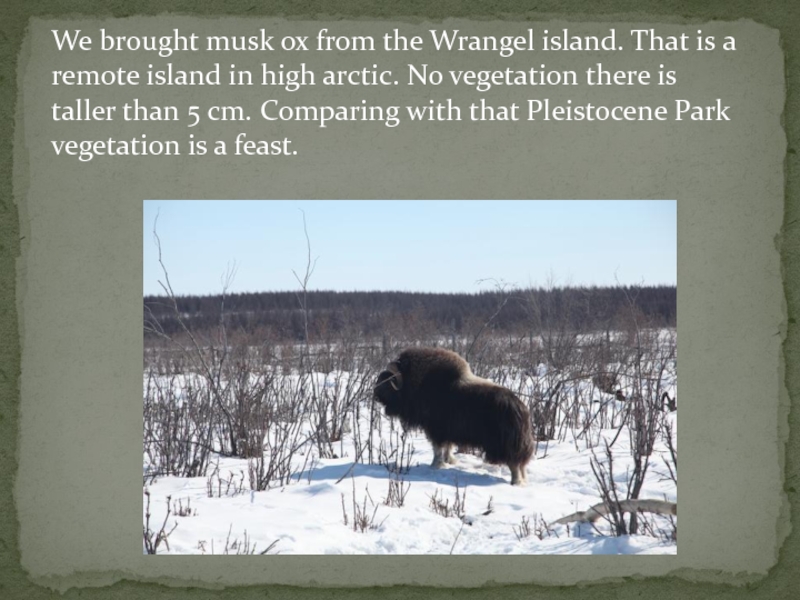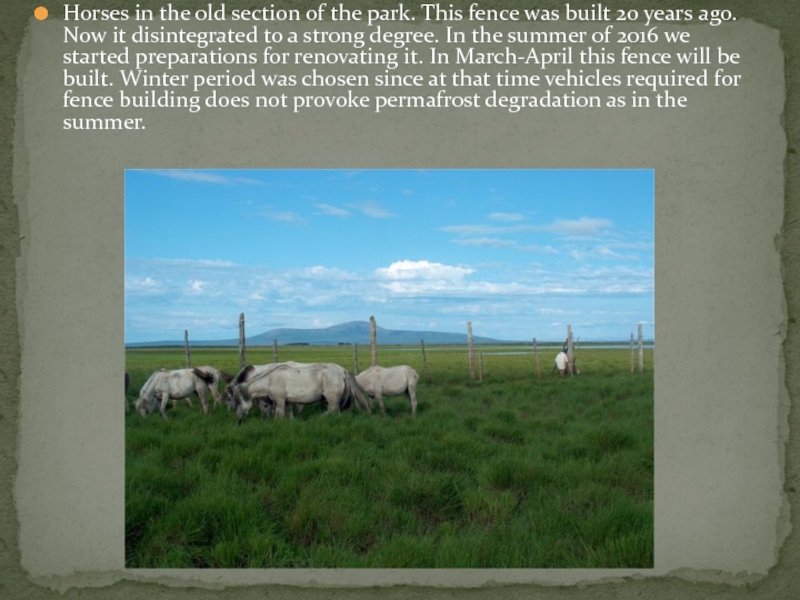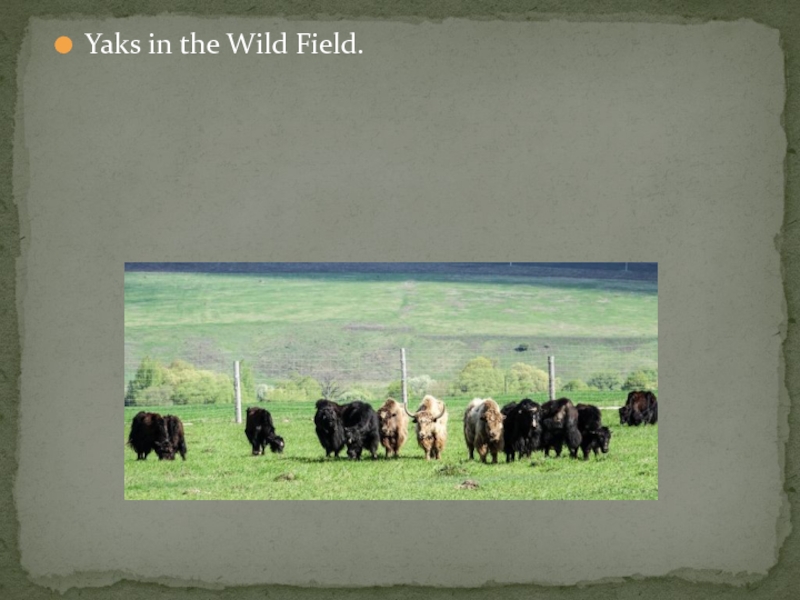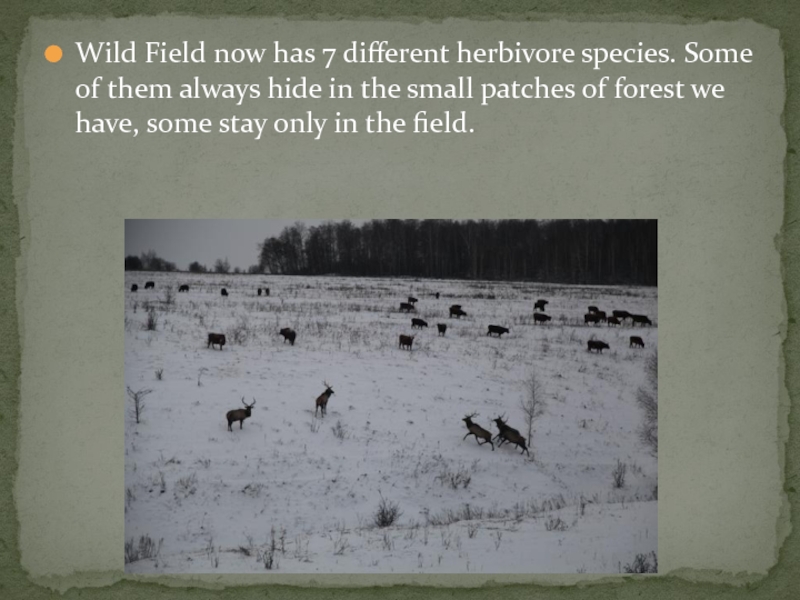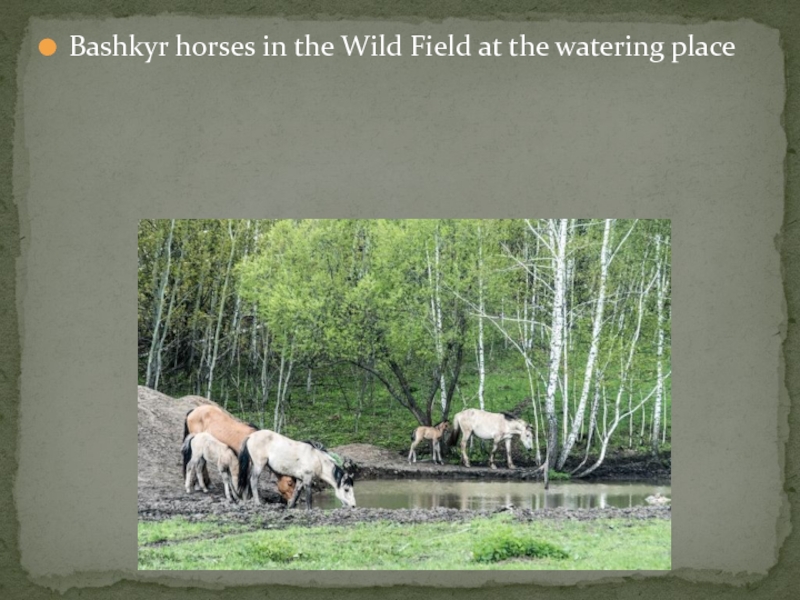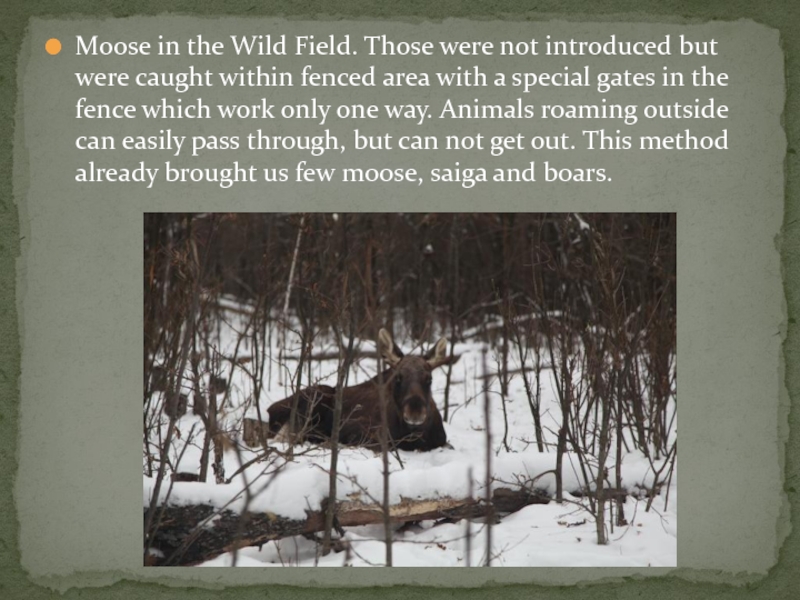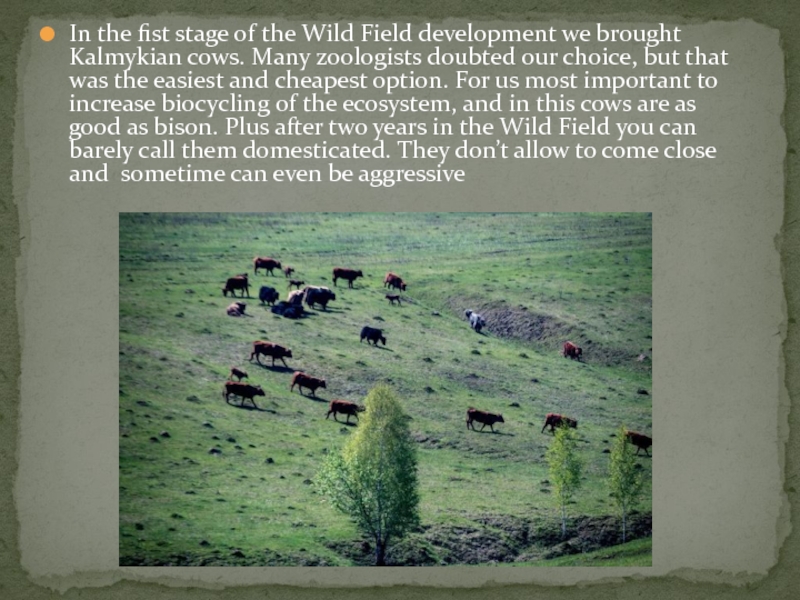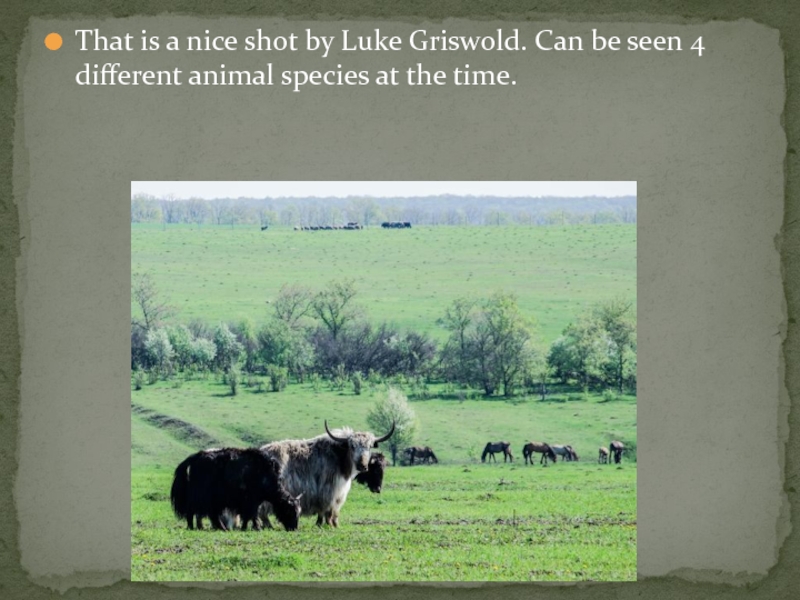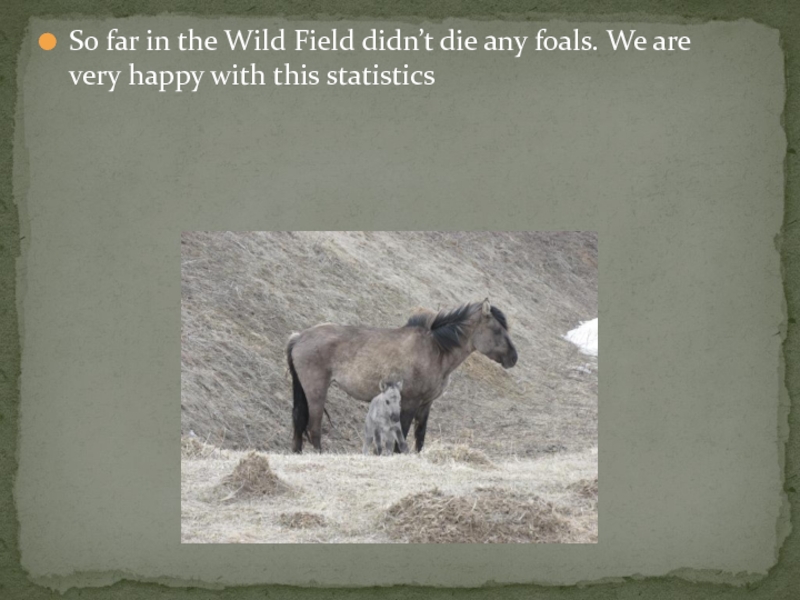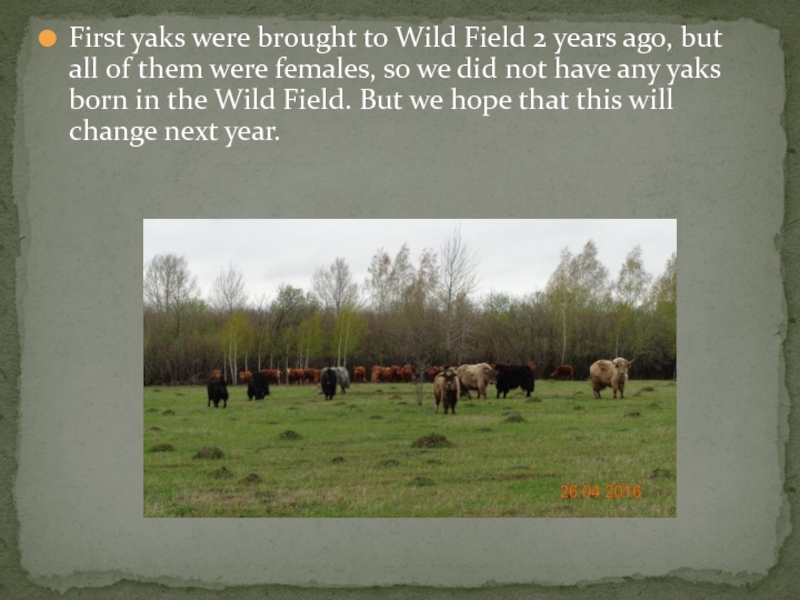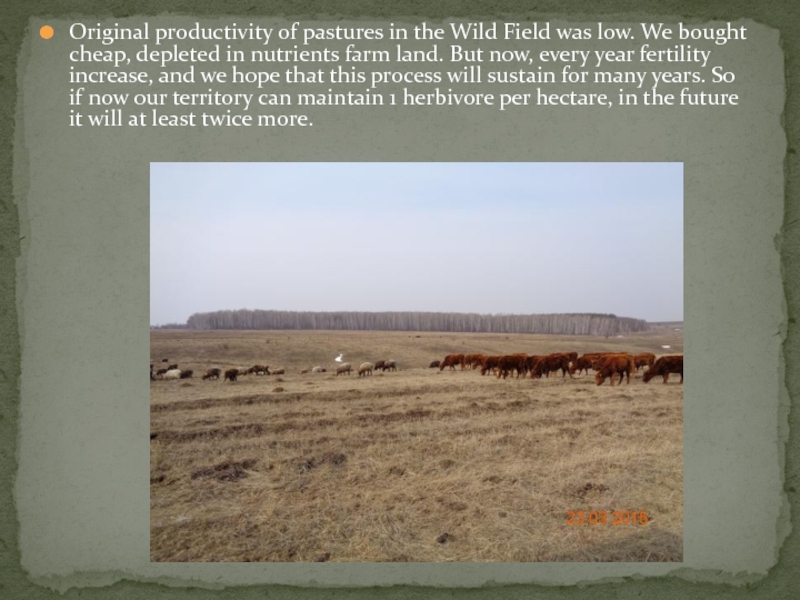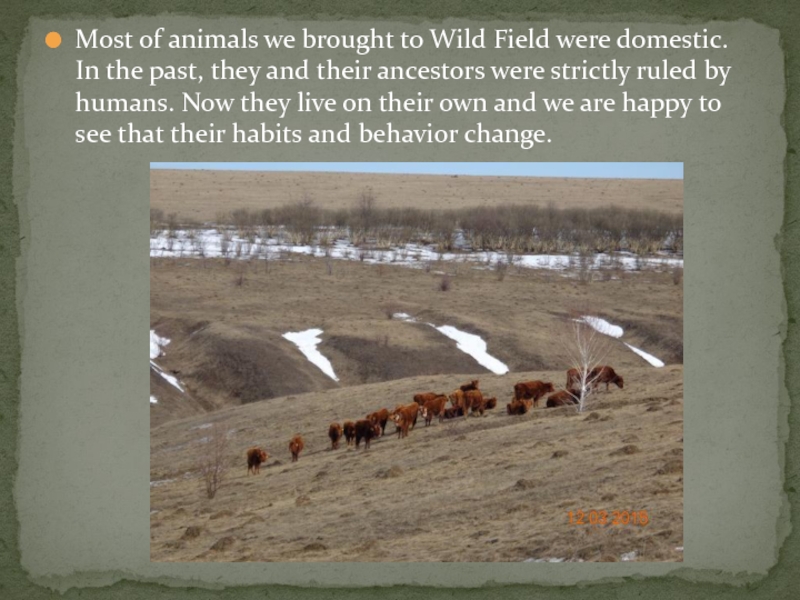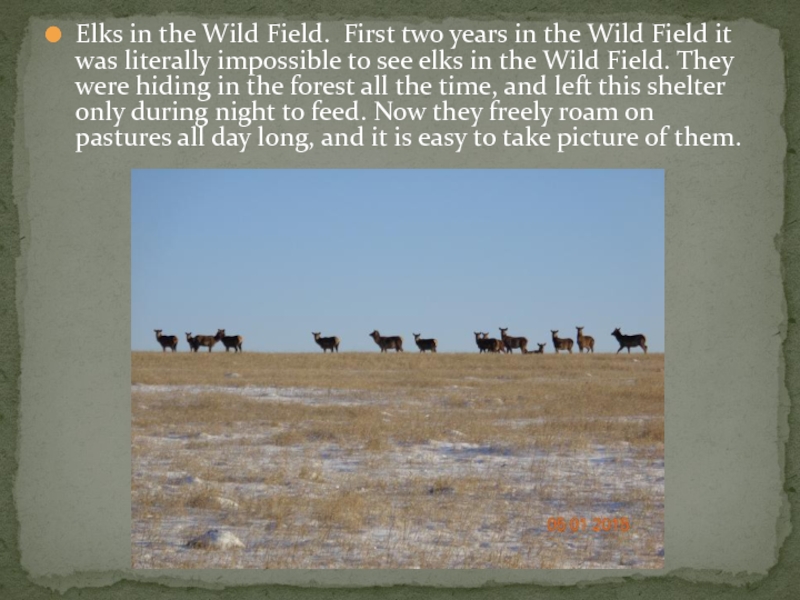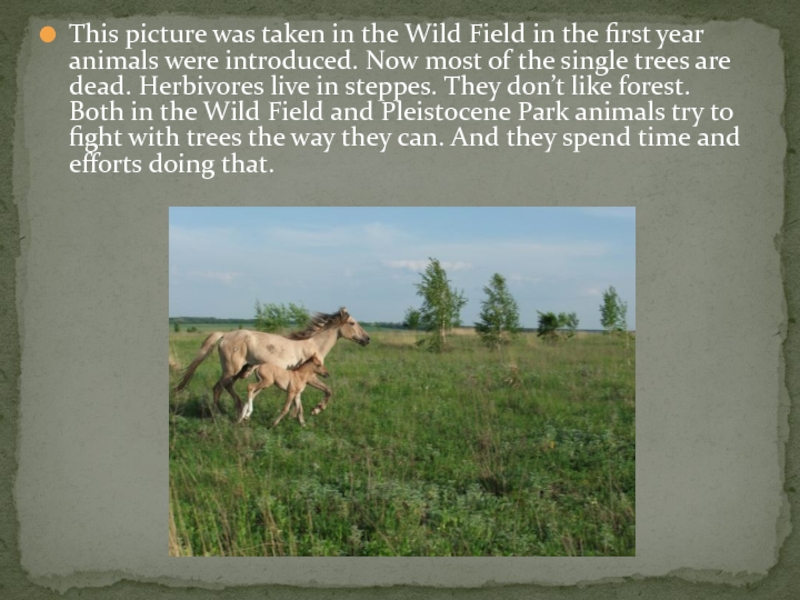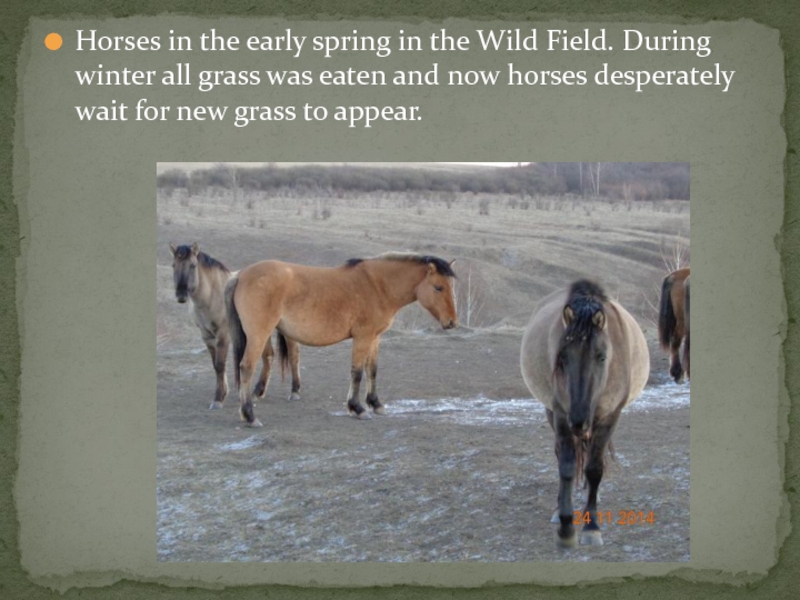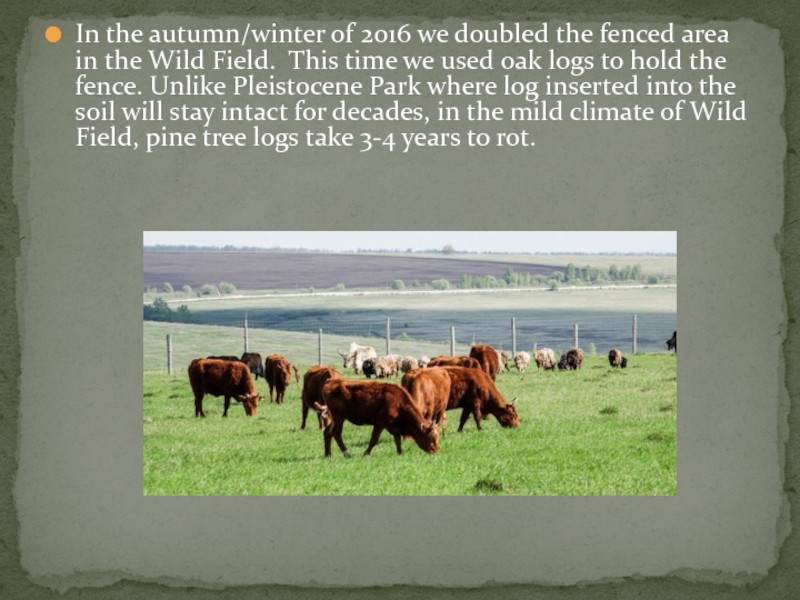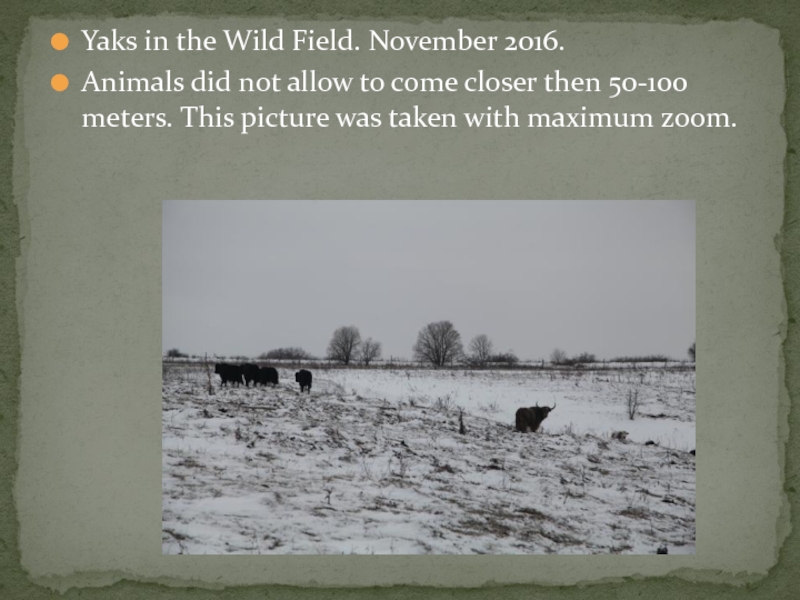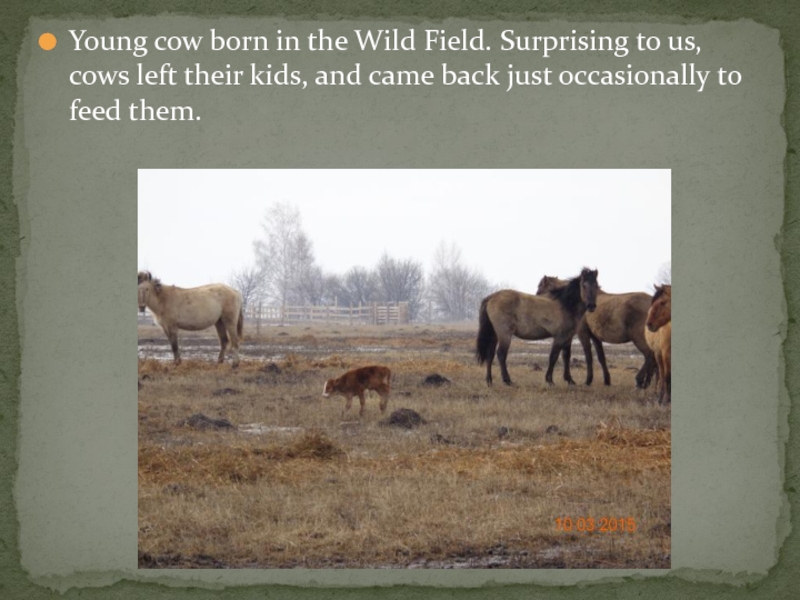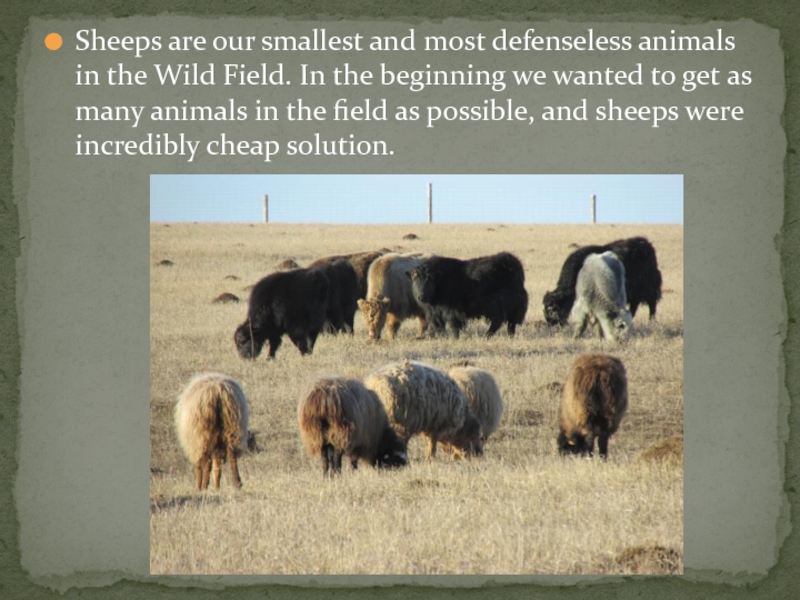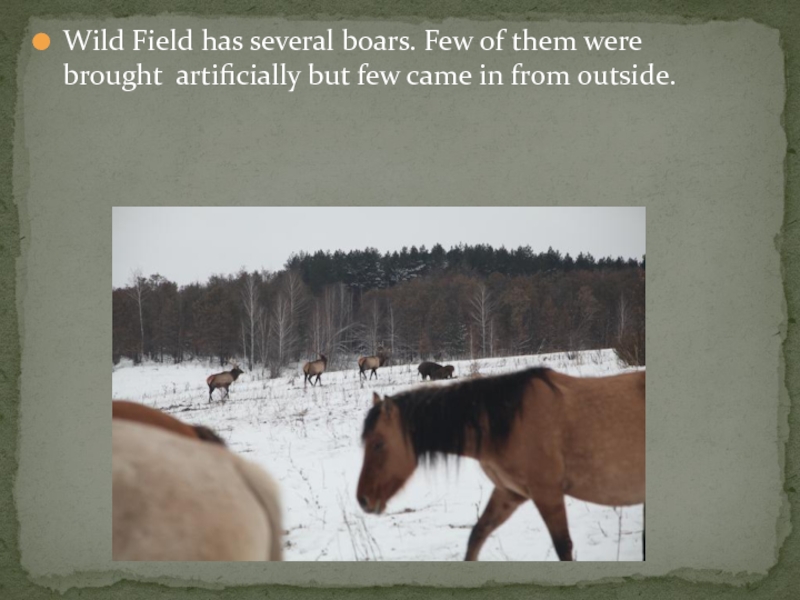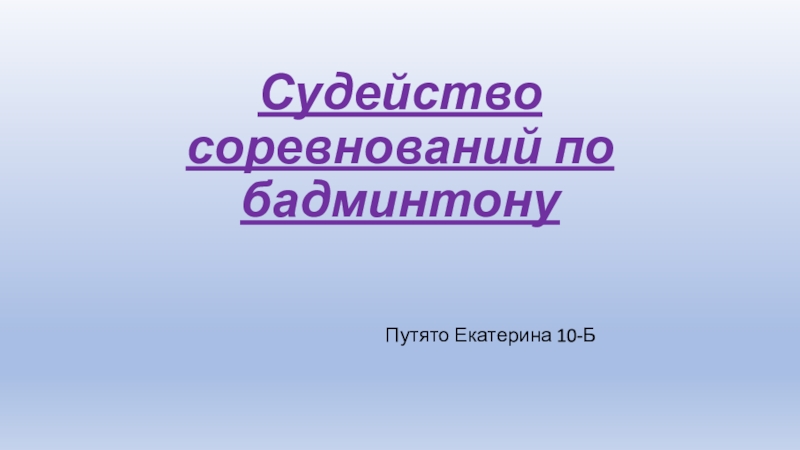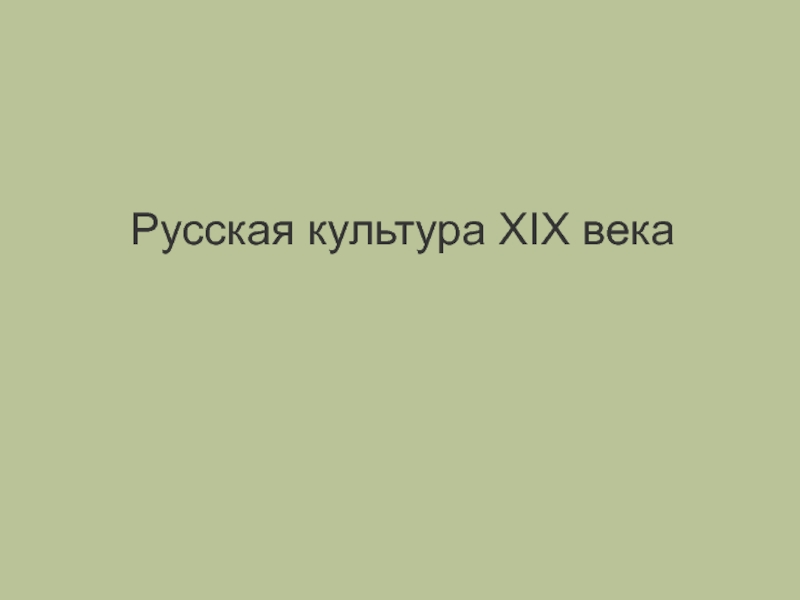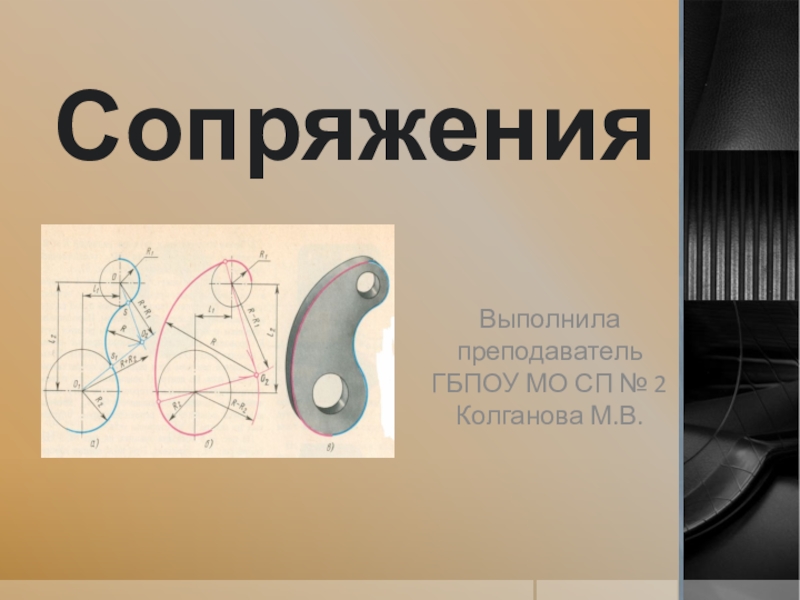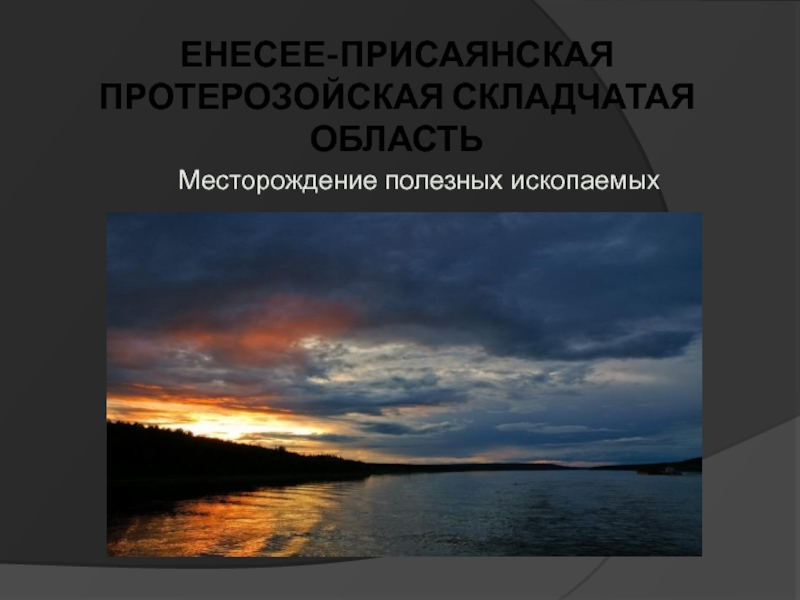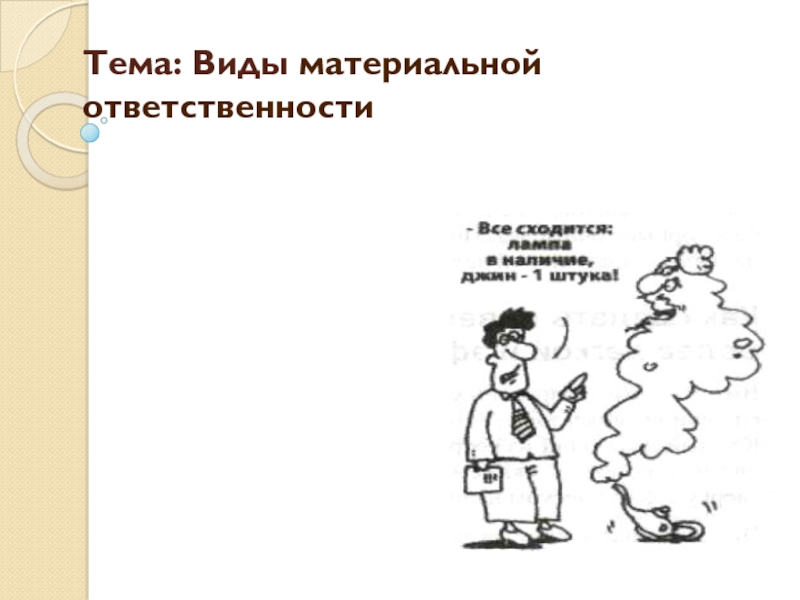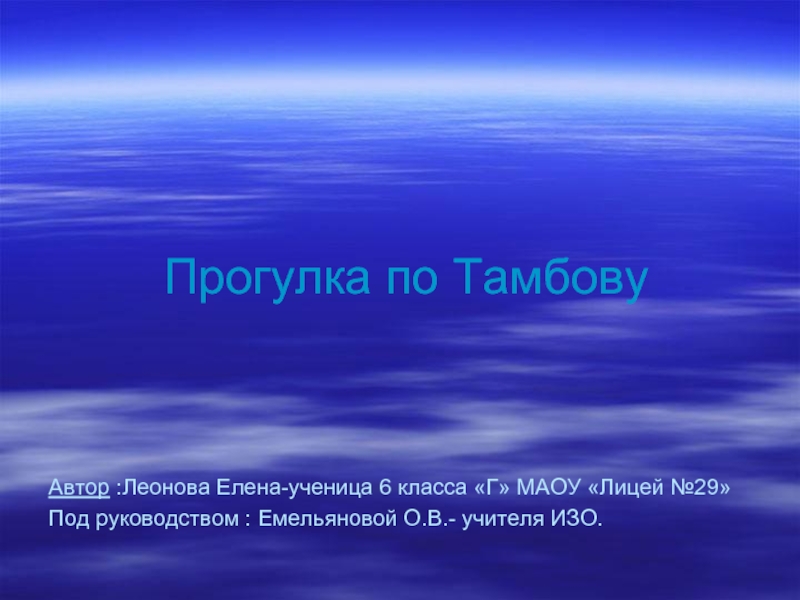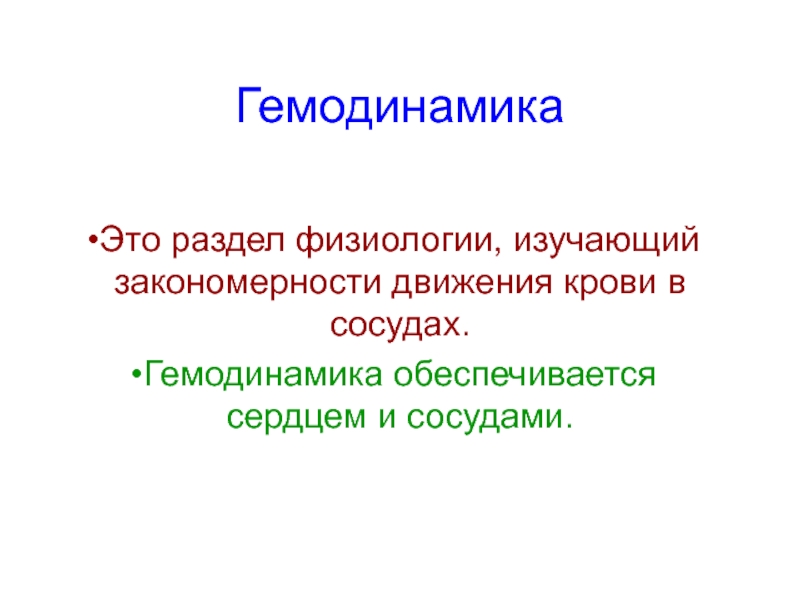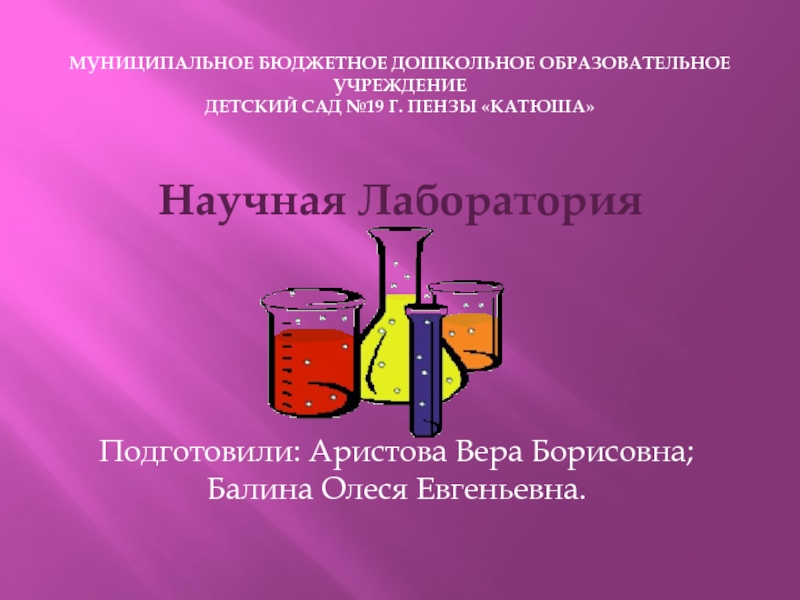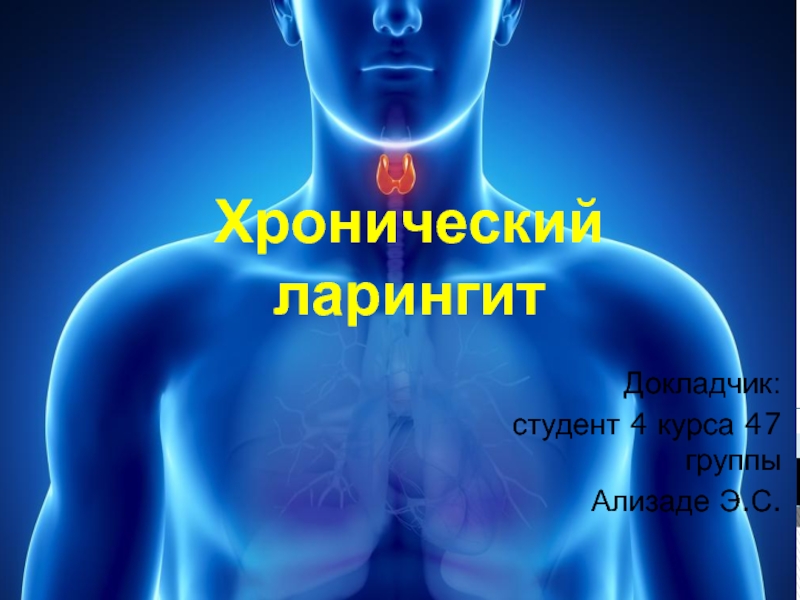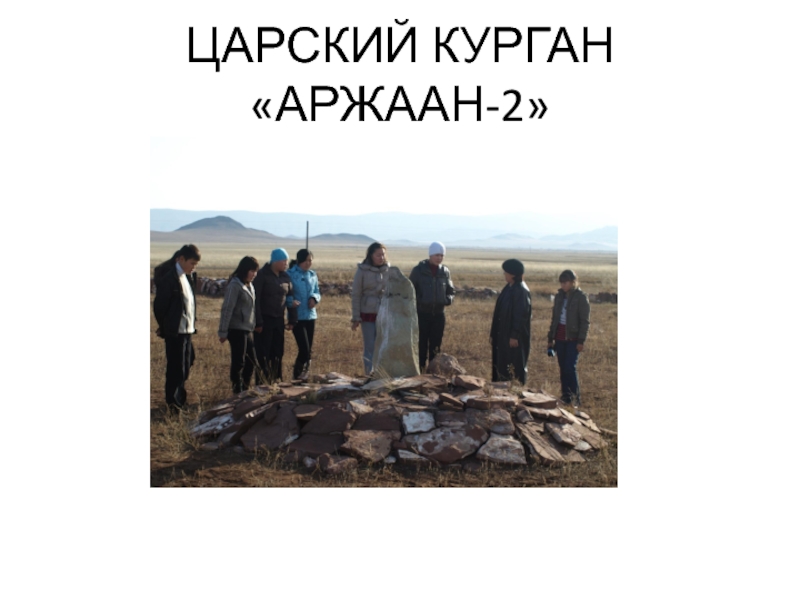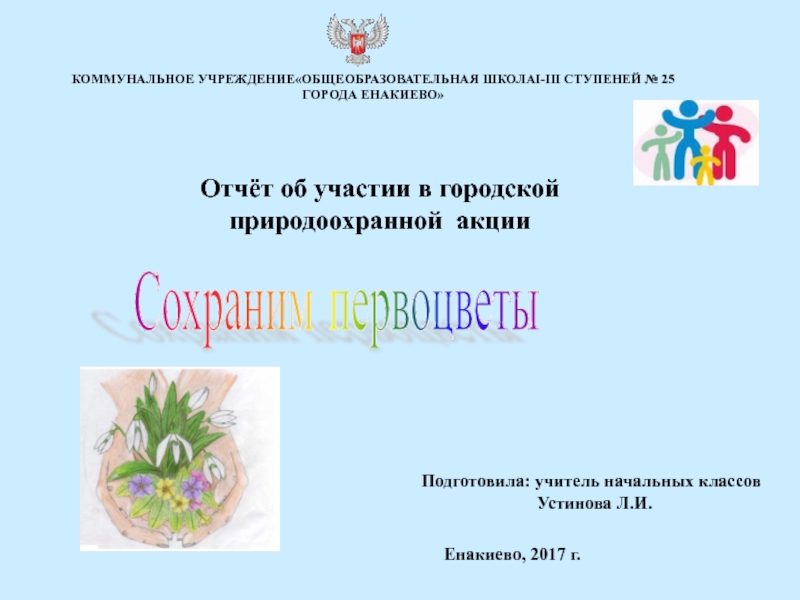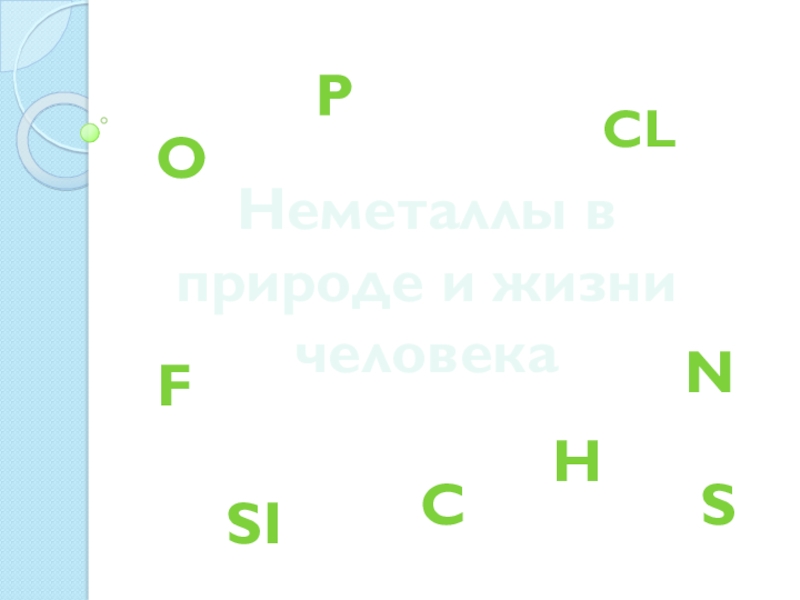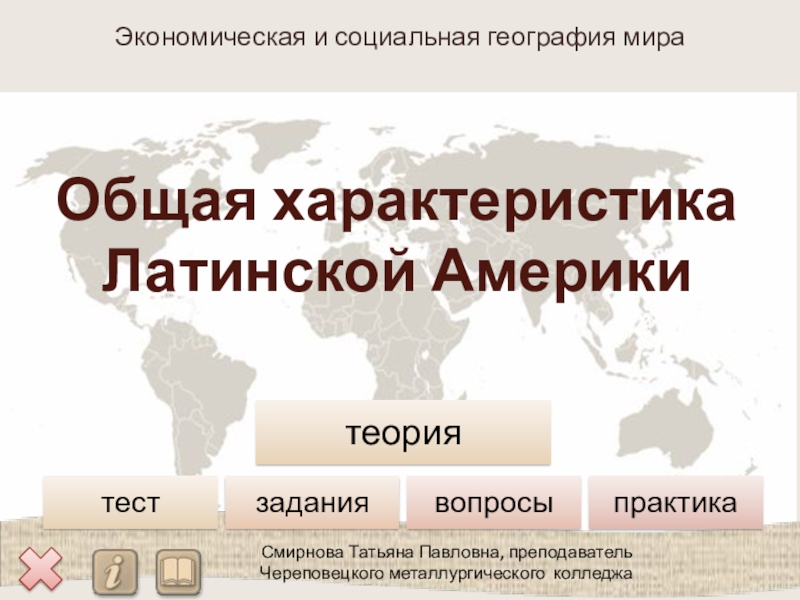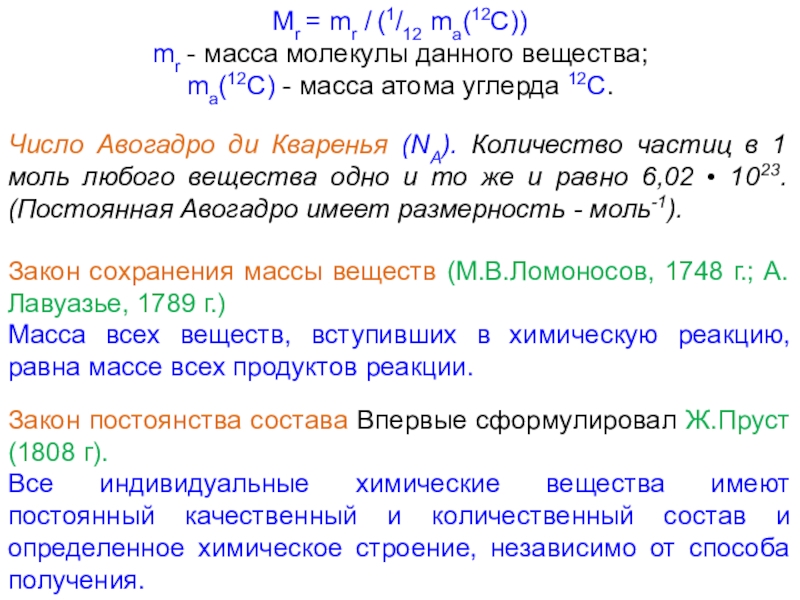Слайд 1Фото для Фэйсбука c сайта проекта Плейстоценовый парк
Презентация
Слайд 2Horses in the Pleistocene Park. In the summer horses tend
to keep open places, where there is less mosquitoes.
Слайд 3By the end of the season most of this land
would have snow trampled. This would allow deeper freezing of
soil and permafrost. But these horses still have lots of work ahead.
Слайд 4Even though we are creating wild steppe ecosystem, I personally
love to pet some of them. However domesticated can be
only moose which were brought in the very first days of their lives. Rest will agree to eat your food, while they are kept in the “kinder garden” but as soon as they grow up, they walk away from the camp and does not visit us anymore.
Слайд 5Main idea of Pleistocene Park is to transform modern ecosystems
to high productive steppes. Here is a good example of
transformation. You can see that all shrubs are broken. Bison and Musk ox are perfect species for that.
Слайд 6Baby moose in the Pleistocene Park. After several years of
introduction we finally have relatively big population of these animals
in the Park. Outside of the Park moose became very rare specie because of poaching.
Слайд 7Musk oxen in the park. That is a very important
specie to have in the park, but also the hardest
one to get
Слайд 8Pastures in the cold environment can rarely experience overgrazing. Animal
density in the wild steppes are limited by availability of
winter forage, so animals can not afford to eat everything in the summer
Слайд 9We never bothered introducing bears, however some native to the
place bears live in the Park. This one loved to
visit camp once in a while. However all Park bears are super polite. None of them ever attacked any herbivores.
Слайд 10Reindeers are animals most easy to introduce to the park.
Reindeer herders are always happy some for a reasonable sum
of money.
Слайд 11In the Park, bison some time can be aggressive towards
moose and reindeers, but always did well with musk oxen.
Possibly because it realize that retaliation may be to tough to handle?
Слайд 12Stallion in the Park. In the winter Yakutian horses wear
long fur, but in the summer it shortens.
Слайд 13Bison and musk oxen trample snow and kill shrubs.
In
the front section of the photo can be seen thick
wooden log. Bison use this log as a toy and love to roll this log on his horns
Слайд 14Winter is a hard time for horses. They don’t eat
shrubs, and their sustainability largely depend on snow depth they
have to excavate.
Слайд 15We brought musk ox from the Wrangel island. That is
a remote island in high arctic. No vegetation there is
taller than 5 cm. Comparing with that Pleistocene Park vegetation is a feast.
Слайд 16Horses in the old section of the park. This fence
was built 20 years ago. Now it disintegrated to a
strong degree. In the summer of 2016 we started preparations for renovating it. In March-April this fence will be built. Winter period was chosen since at that time vehicles required for fence building does not provoke permafrost degradation as in the summer.
Слайд 18Wild Field now has 7 different herbivore species. Some of
them always hide in the small patches of forest we
have, some stay only in the field.
Слайд 19Bashkyr horses in the Wild Field at the watering place
Слайд 20Moose in the Wild Field. Those were not introduced but
were caught within fenced area with a special gates in
the fence which work only one way. Animals roaming outside can easily pass through, but can not get out. This method already brought us few moose, saiga and boars.
Слайд 21Wild Field has much milder climate comparing with Pleistocene Park
and animals have much higher birth and survival rate. So
in the wild field we are limited with territory and fertility of soil. On both of these factors we actively focus
Слайд 22In the fist stage of the Wild Field development we
brought Kalmykian cows. Many zoologists doubted our choice, but that
was the easiest and cheapest option. For us most important to increase biocycling of the ecosystem, and in this cows are as good as bison. Plus after two years in the Wild Field you can barely call them domesticated. They don’t allow to come close and sometime can even be aggressive
Слайд 23That is a nice shot by Luke Griswold. Can be
seen 4 different animal species at the time.
Слайд 24So far in the Wild Field didn’t die any foals.
We are very happy with this statistics
Слайд 25First yaks were brought to Wild Field 2 years ago,
but all of them were females, so we did not
have any yaks born in the Wild Field. But we hope that this will change next year.
Слайд 26Original productivity of pastures in the Wild Field was low.
We bought cheap, depleted in nutrients farm land. But now,
every year fertility increase, and we hope that this process will sustain for many years. So if now our territory can maintain 1 herbivore per hectare, in the future it will at least twice more.
Слайд 27Most of animals we brought to Wild Field were domestic.
In the past, they and their ancestors were strictly ruled
by humans. Now they live on their own and we are happy to see that their habits and behavior change.
Слайд 28Elks in the Wild Field. First two years in the
Wild Field it was literally impossible to see elks in
the Wild Field. They were hiding in the forest all the time, and left this shelter only during night to feed. Now they freely roam on pastures all day long, and it is easy to take picture of them.
Слайд 29This picture was taken in the Wild Field in the
first year animals were introduced. Now most of the single
trees are dead. Herbivores live in steppes. They don’t like forest. Both in the Wild Field and Pleistocene Park animals try to fight with trees the way they can. And they spend time and efforts doing that.
Слайд 30Horses in the early spring in the Wild Field. During
winter all grass was eaten and now horses desperately wait
for new grass to appear.
Слайд 31In the autumn/winter of 2016 we doubled the fenced area
in the Wild Field. This time we used oak logs
to hold the fence. Unlike Pleistocene Park where log inserted into the soil will stay intact for decades, in the mild climate of Wild Field, pine tree logs take 3-4 years to rot.
Слайд 32Yaks in the Wild Field. November 2016.
Animals did not
allow to come closer then 50-100 meters. This picture was
taken with maximum zoom.
Слайд 33Young cow born in the Wild Field. Surprising to us,
cows left their kids, and came back just occasionally to
feed them.
Слайд 34Sheeps are our smallest and most defenseless animals in the
Wild Field. In the beginning we wanted to get as
many animals in the field as possible, and sheeps were incredibly cheap solution.
Слайд 35Wild Field has several boars. Few of them were brought
artificially but few came in from outside.
